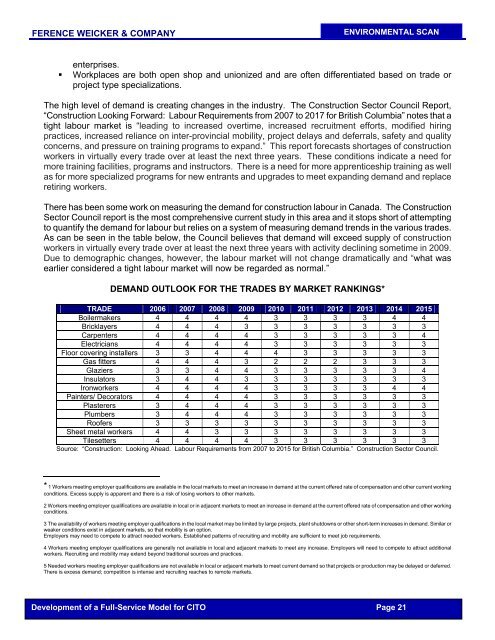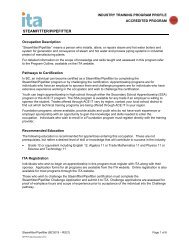CITO - Phase I Report - Industry Training Authority
CITO - Phase I Report - Industry Training Authority
CITO - Phase I Report - Industry Training Authority
Create successful ePaper yourself
Turn your PDF publications into a flip-book with our unique Google optimized e-Paper software.
FERENCE WEICKER & COMPANY<br />
ENVIRONMENTAL SCAN<br />
enterprises.<br />
� Workplaces are both open shop and unionized and are often differentiated based on trade or<br />
project type specializations.<br />
The high level of demand is creating changes in the industry. The Construction Sector Council <strong>Report</strong>,<br />
“Construction Looking Forward: Labour Requirements from 2007 to 2017 for British Columbia” notes that a<br />
tight labour market is “leading to increased overtime, increased recruitment efforts, modified hiring<br />
practices, increased reliance on inter-provincial mobility, project delays and deferrals, safety and quality<br />
concerns, and pressure on training programs to expand.” This report forecasts shortages of construction<br />
workers in virtually every trade over at least the next three years. These conditions indicate a need for<br />
more training facilities, programs and instructors. There is a need for more apprenticeship training as well<br />
as for more specialized programs for new entrants and upgrades to meet expanding demand and replace<br />
retiring workers.<br />
There has been some work on measuring the demand for construction labour in Canada. The Construction<br />
Sector Council report is the most comprehensive current study in this area and it stops short of attempting<br />
to quantify the demand for labour but relies on a system of measuring demand trends in the various trades.<br />
As can be seen in the table below, the Council believes that demand will exceed supply of construction<br />
workers in virtually every trade over at least the next three years with activity declining sometime in 2009.<br />
Due to demographic changes, however, the labour market will not change dramatically and “what was<br />
earlier considered a tight labour market will now be regarded as normal.”<br />
DEMAND OUTLOOK FOR THE TRADES BY MARKET RANKINGS*<br />
TRADE 2006 2007 2008 2009 2010 2011 2012 2013 2014 2015<br />
Boilermakers 4 4 4 4 3 3 3 3 4 4<br />
Bricklayers 4 4 4 3 3 3 3 3 3 3<br />
Carpenters 4 4 4 4 3 3 3 3 3 4<br />
Electricians 4 4 4 4 3 3 3 3 3 3<br />
Floor covering installers 3 3 4 4 4 3 3 3 3 3<br />
Gas fitters 4 4 4 3 2 2 2 3 3 3<br />
Glaziers 3 3 4 4 3 3 3 3 3 4<br />
Insulators 3 4 4 3 3 3 3 3 3 3<br />
Ironworkers 4 4 4 4 3 3 3 3 4 4<br />
Painters/ Decorators 4 4 4 4 3 3 3 3 3 3<br />
Plasterers 3 4 4 4 3 3 3 3 3 3<br />
Plumbers 3 4 4 4 3 3 3 3 3 3<br />
Roofers 3 3 3 3 3 3 3 3 3 3<br />
Sheet metal workers 4 4 3 3 3 3 3 3 3 3<br />
Tilesetters 4 4 4 4 3 3 3 3 3 3<br />
Source: “Construction: Looking Ahead. Labour Requirements from 2007 to 2015 for British Columbia.” Construction Sector Council.<br />
* 1 Workers meeting employer qualifications are available in the local markets to meet an increase in demand at the current offered rate of compensation and other current working<br />
conditions. Excess supply is apparent and there is a risk of losing workers to other markets.<br />
2 Workers meeting employer qualifications are available in local or in adjacent markets to meet an increase in demand at the current offered rate of compensation and other working<br />
conditions.<br />
3 The availability of workers meeting employer qualifications in the local market may be limited by large projects, plant shutdowns or other short-term increases in demand. Similar or<br />
weaker conditions exist in adjacent markets, so that mobility is an option.<br />
Employers may need to compete to attract needed workers. Established patterns of recruiting and mobility are sufficient to meet job requirements.<br />
4 Workers meeting employer qualifications are generally not available in local and adjacent markets to meet any increase. Employers will need to compete to attract additional<br />
workers. Recruiting and mobility may extend beyond traditional sources and practices.<br />
5 Needed workers meeting employer qualifications are not available in local or adjacent markets to meet current demand so that projects or production may be delayed or deferred.<br />
There is excess demand; competition is intense and recruiting reaches to remote markets.<br />
Development of a Full-Service Model for <strong>CITO</strong> Page 21












